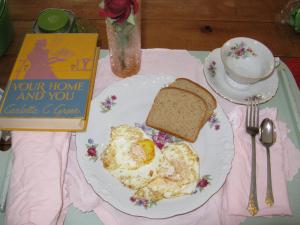After some consideration, I have decided to rerun a series that I wrote on my previous blog. It was a series based on a 1948 Home Economics book that I found during one of my vintage shopping excursions. I adore this book. Although dated in some content, it is spot on for much of today’s living as well as it’s intended 1948 audience. I hope you will enjoy this series. (click here to read my original introduction)
LESSON TWO
Before I start Lesson Two, you may want a refresher of Lesson One…click here. OK, let’s get started.
The following was originally written February 24, 2011:

Welcome back! Today’s lesson is an important one for all: Avoiding Illness. Helping the Sick in Your Home
I think it is charming that this book contains a chapter on how to help sick family members. Some of the advice is very archaic and out of date, so I won’t spend much time on those but sharing some of the principles and advice will warrant some smiles. But before we deal with sickness, we need to find out how to avoid it, if possible.
“Headaches, sore throats, colds and other minor ailments are nothing to be proud of”, thus we need to know the eight simple health rules:
- “Take a full bath oftener than once a week–daily if possible (I like how she thinks).
- Brush the teeth at least twice a day.
- Sleep long hours (yes!) in a room in which fresh air can enter. Do not, however, sleep in a draft.
- Drink from six to eight glasses of water a day (I really wonder how long this rule has been around–we find out more as to why this is so important in just moments).
- Eat the proper foods and wash your hands carefully before meals. (the reader is referred back to page 11 which has the “Essential Foods to Use Each Day”*)
- Spend some time every day out of doors, part of the time in the sun when possible.
- Have a bowel movement every day (with this one sentence, I started understanding my grandmother more).
- Keep your emotions under control. Do not allow yourself to become excessively excited or angry.”
So there you go…eight simple rules for optimal health. Apparently #7 was a big one back in the day because the next section talks about the importance of avoiding constipation. How does one do this? Drinking her water first and foremost. This should be your water drinking schedule:
- a) 1 or 2 , on rising (2)
- b) 1, before or during each meal (3)
- c)1, middle of forenoon (1)
- d)1, middle of afternoon (1)
- TOTAL 7
Also, one should eat “plenty of fruits and vegetables, not overeat, take exercise every day and establish the habit of a bowel movement at a regular time each day”. LOL!!! I couldn’t help but laugh about the bowel movements and the importance they play in good health. Yes, I know, optimally this is a great “goal” and it does make sense. Why I found it so funny is that my Grandmother, bless her heart, was overly concerned by her bowels–we heard about them all. the. time. When she died, we were curious about a journal she left behind–I don’t know why. It was the day by day saga of her BMs. But hey, if this is what she learned about in her Home Economics class, then I get it now. Poor Grandma.
The next sections deal with: Avoiding Colds, Treatment of Minor Injuries (some of the first-aid treatments have definitely changed since 1948), what to have in your Home Medicine Cabinet, Deciding When to Call the Doctor (including step by step direction on how to take someone’s temperature–thankfully described by mouth).
Caring for the Sick had some excellent suggestions worth sharing:
“1. Wring out a clean washcloth in warm water and take it with a towel to the patient to wash and dry her face. The patient may be more comfortable if this is done several times during the day.
2. Bring a brush and comb for the patient to use (I would be requiring lip-gloss as well).
3. See that there is drinking water in the sickroom…
4. If the patient is unable to go to the bathroom, bring the bedpan. Have the pan dry and warm…
5. Give the patient a bath. Your teacher or nurse will probably demonstrate how this should be done. (I want to know HOW this was demonstrated. Did they ask for volunteers? Were you taken into a little dark room all by yourself? Yikes.)
6. See that the shades are adjusted so that no glaring light shines in the patient’s eyes.
7. Ventilate the room.
8. Keep the room neat. In cleaning it, try not to raise or scatter dust (how considerate!)
9. If possible, put flowers in the room. Arrange them attractively. Change the water often, discarding wilted flowers.
10. Be cheerful in the sickroom. Say nothing to alarm the patient.”
OH MY! My nursing, care-giving skills could use some fine-tuning. My favorites are…nevermind, I can’t choose. These all had me laughing. “Say nothing to alarm the patient”…so if I tell my husband that if he doesn’t take care of his cold, it’s going to turn into pneumonia and he will die, isn’t considered caring? As if!
Next Diets for the Sick are discussed. The only point I will share from this is how to make broth or beef tea: “To make beef tea soak 1 pound chopped beef in 1 pint of water for at least 1 hour in a cool place. Then stir and cook the meat over hot water until it becomes reddish-brown in color. (The broth should be taken from the stove before it loses all its red tint.) Pour through a course strainer. Season slightly. Serve at once.”
You know, this will not be done in this home–ever. I think we will stick with Green tea and Echinacea tablets.
And one final thing to consider is The Sickroom Tray (oh yes, for real). This is an important element in caring for the sick so you will want to make sure that it looks “as attractive as possible”. Here is how that is done:
“1. Use clean linens (translate: Bounty paper towel)–a napkin to cover the tray, one to cover the food while carrying it from the kitchen to bedroom, one to protect the bed, and one for the patient to use (which equals 1 load of laundry for every tray served during the day).
2. Use dainty china, selecting for hot foods dishes with covers or some that may be covered with saucers or plates. Hot food may become cool in transit.(you know…I…hmmm…)
3. Serve dainty portions of foods (no foot long hotdogs?). Large amounts sometimes disgust a sick person. If he can eat more, he will probably ask for it.
4. Garnish the foods attractively, unusually, if possible (because this is definitely something your cranky, feverish patient will take time to appreciate). A flower laid on the tray or held in a not-too-tall bud vase may be pleasing. To cheer the patient, put something amusing on the tray, such as a clipping from a funny-story (an excerpt from this chapter) column or in the case of a child, a toy or an animal made of fruits or vegetables.”

- i think my re-created sick tray may have earned me a C+ (i hurriedly created this so my linens are wrinkled but the funny thing to read is present!)
(Wiping eyes). OK, I am not mocking the “principles” involved here but rather some of the “practices”. Can I take from this and improve in my care-giving skills? Absolutely. But the one thing missing from this list (or is it?), is the importance of having a sense of humor. If one is truly putting this much time, thought, self-sacrifice into caring for someone–then she sure as heck better be finding some ways to laugh. However, in comparing this advice to the world we live in, where some families do not take the time to even visit loved ones in nursing homes, or we hear of horrible abuse taking place at the hands of those providing care, then yes, I would rather be practicing these suggestions.
So, what have you learned today that you will be implementing in your life-style?
*ESSENTIAL FOODS TO USE EACH DAY: Milk–adults 1 pint; children 1.5 pints to 1 quart; Eggs–1 daily or at least 3 or 4 a week; Meat–1 serving (up to 3 ounces); Vegetables–2 servings. One leafy, green or yellow; Fruits–2 servings. One citrus or tomato, and one other, as apples, prunes, etc.; Potato–one or more servings; Bread and Cereal–Most or preferably all whole grain or “enriched”; Butter–or oleomargarine fortified with Vitamin A; Sugar and Fat –(to supply sufficient calories) For use in preparation of food. –from page 11 in “Your Home and You”.
I hope you enjoyed Lesson 2. I will bet you can’t wait for #3. : )
~~Heather~~

